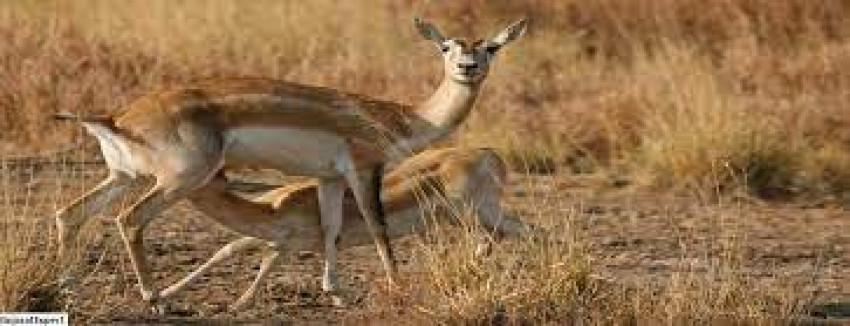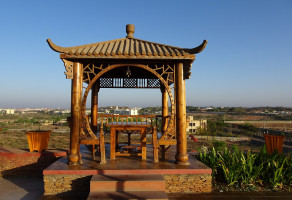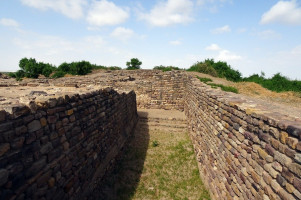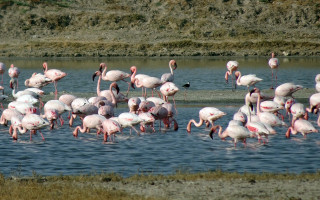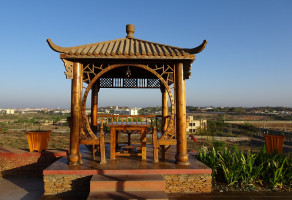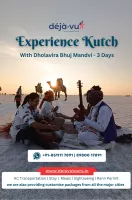Kutch Desert Wildlife Sanctuary Travel Guide
Located in the picturesque state of Gujarat, India, Kutch Desert Wildlife Sanctuary is a mesmerizing destination known for its unique ecosystem and diverse wildlife. Covering an area of over 7505 square kilometers, this sanctuary is a haven for nature enthusiasts and wildlife lovers alike. The region's history dates back to ancient times, with a rich cultural heritage that can be traced through its traditional art, handicrafts, and vibrant festivals. Kutch Desert Wildlife Sanctuary is famous for its vast stretches of arid desert landscapes, dotted with rare flora and fauna, making it a must-visit for anyone seeking an offbeat and adventurous travel experience.Top Attractions in Kutch Desert Wildlife Sanctuary
- Wildlife Safari to spot the endangered Indian Wild Ass
- Flamingo Colony at the Great Rann of Kutch
- Kala Dungar (Black Hill) for panoramic views of the desert
- Handicraft Villages showcasing traditional art and textiles
Kutch Desert Wildlife Sanctuary is Famous for
Its unique ecosystem and the chance to witness the majestic Indian Wild Ass in its natural habitat.Top Attractions in Kutch Desert Wildlife Sanctuary
- Wildlife Safari to spot the endangered Indian Wild Ass
- Flamingo Colony at the Great Rann of Kutch
- Kala Dungar (Black Hill) for panoramic views of the desert
- Handicraft Villages showcasing traditional art and textiles
What's Great about Travelling to Kutch Desert Wildlife Sanctuary?
- Unique wildlife sightings
- Cultural immersion in traditional art and craft
- Breathtaking desert landscapes
What's Not So Great about Travelling to Kutch Desert Wildlife Sanctuary?
- Extreme temperatures during summers
- Limited accommodation options
- Remote location
Travel Tips for Kutch Desert Wildlife Sanctuary
- Obtain necessary permits for entry
- Carry sufficient water and sun protection
- Respect local customs and wildlife
Important Kutch Desert Wildlife Sanctuary trip information
- Ideal Duration: 2-3 days to explore the sanctuary and nearby attractions
- Best Time to Visit: November to February for pleasant weather
- Nearby Airports and Railway Stations: Bhuj Airport and Bhuj Railway Station
Per Person
20,288
*EXCLUDING APPLICABLE TAXES Per Person
24,548
*EXCLUDING APPLICABLE TAXES 4.9 Ratings
( 200 Reviews )
( 200 Reviews )
Per Person
13,960
*EXCLUDING APPLICABLE TAXES Per Person
17,520
*EXCLUDING APPLICABLE TAXES Per Person
8,990
*EXCLUDING APPLICABLE TAXES Per Person
18,900
*EXCLUDING APPLICABLE TAXES FAQ's on Kutch Desert Wildlife Sanctuary
Q1: What is the best time to visit Kutch Desert Wildlife Sanctuary?
The best time to visit Kutch Desert Wildlife Sanctuary is during the winter months from October to March when the weather is pleasant and cool. This period coincides with the Rann Utsav, a cultural festival that showcases the vibrant culture of the region. Avoid visiting during the monsoon season as the sanctuary may be inaccessible due to heavy rainfall.
Q2: Do I need a visa to travel to Kutch Desert Wildlife Sanctuary?
Foreign tourists visiting Kutch Desert Wildlife Sanctuary will require a valid Indian tourist visa. Visa regulations may vary depending on your nationality, so it is advisable to check with the nearest Indian embassy or consulate. Visitors from neighboring countries like Nepal and Bhutan may have certain exemptions. Make sure to have your visa in order before planning your trip.
Q3: What are the must-visit attractions in Kutch Desert Wildlife Sanctuary?
The must-visit attractions in Kutch Desert Wildlife Sanctuary include the Great Indian Bustard Sanctuary, Narayan Sarovar Sanctuary, and Kala Dungar (Black Hill) offering panoramic views of the Rann of Kutch. Don't miss the Rann of Kutch itself, especially during the Rann Utsav for cultural experiences. Explore local handicraft villages like Hodka and Dhordo for traditional crafts and textiles.
Q4: Is Kutch Desert Wildlife Sanctuary a safe place to travel?
Kutch Desert Wildlife Sanctuary is generally safe for travelers. However, it is advisable to follow standard safety precautions such as avoiding isolated areas at night and keeping an eye on your belongings. Be cautious while exploring the desert terrain and wildlife areas. Consult local authorities or tour guides for any specific safety concerns.
Q5: What is the local currency in Kutch Desert Wildlife Sanctuary and can I use credit cards?
The local currency in Kutch Desert Wildlife Sanctuary is the Indian Rupee (INR). While credit cards are accepted in major hotels and establishments in cities like Bhuj, it is recommended to carry cash for transactions in rural areas and local markets. ATMs are available in towns for convenient cash withdrawals.
Q6: What is the local cuisine like in Kutch Desert Wildlife Sanctuary?
The local cuisine in Kutch Desert Wildlife Sanctuary is a delightful blend of flavors influenced by Gujarati and Rajasthani traditions. Don't miss trying traditional dishes like Khichdi, Kadi, Bajra Rotla, and local sweets like Malpua and Lapsi. Vegetarian options are predominant due to cultural preferences. Be mindful of spicy levels and inform the cooks if you prefer milder dishes.
Q7: What transportation options are available in Kutch Desert Wildlife Sanctuary?
Transportation options in Kutch Desert Wildlife Sanctuary include buses, taxis, and private cars for getting around. Public buses connect major towns like Bhuj to the sanctuary. Taxis and auto-rickshaws are available for shorter distances. Renting a car or hiring a local guide for desert excursions is recommended for exploring the vast sanctuary and its attractions.
Q8: Are there any cultural norms or etiquette I should be aware of when visiting Kutch Desert Wildlife Sanctuary?
When visiting Kutch Desert Wildlife Sanctuary, it is important to respect local customs and traditions. Dress modestly, especially when visiting religious sites or rural areas. Remove your shoes before entering temples or homes. Ask for permission before taking photographs of locals, especially in villages. Greet people with a 'Namaste' and be polite in interactions. Avoid public displays of affection and follow designated rules in wildlife areas to ensure a harmonious visit.
Q9: I am a travel agent. How can I buy travel leads of Kutch Desert Wildlife Sanctuary?
Register yourself as a travel agent at agents.tripclap.com and then you can buy travel leads to Kutch Desert Wildlife Sanctuary once your account is approved. For more details contact our support team at +91-8069186564 or support@tripclap.com
